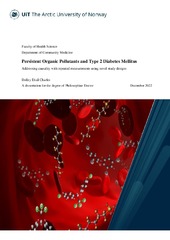| dc.contributor.advisor | Rylander, Charlotta | |
| dc.contributor.author | Charles, Dolley Dixil | |
| dc.date.accessioned | 2023-04-12T07:39:09Z | |
| dc.date.available | 2023-04-12T07:39:09Z | |
| dc.date.issued | 2023-05-05 | |
| dc.description.abstract | <p><i>Background:</i> Persistent Organic Pollutants (POPs) are chemicals that have negative impacts on the environment and biota and have been investigated as possible risk factors for Type 2 Diabetes Mellitus (T2DM). Other well-established risk factors for T2DM, for example, obesity, increased lipids, and age have been reported to influence human POP concentrations. Previous studies have reported positive associations between single POP measurement and prevalent and incident T2DM, although causality has not been established. Longitudinal studies with repeated pre-diagnostic POP measurements, which may help in addressing causality, are lacking.
<p><i>Aims:</i> This thesis aimed to investigate if the different classes of POPs (perfluoroalkyl acids [PFAAs], polychlorinated biphenyls [PCBs], organochlorine pesticides [OCPs], and polybrominated diphenyl ethers [PBDEs]) are causal factors of T2DM using repeated POP measurements from the same individuals. We also assessed if T2DM status influences the body burden of POPs.
<p><i>Methods:</i> We used questionnaire data and blood samples from two different population-based studies. The Norwegian Women and Cancer study was used to investigate PFAAs-T2DM associations and time trends in PFAAs (2001-2005/06) with two repeated measurements. The Tromsø study was used to study the associations between PCBs, OCPs, PBDEs, and T2DM, and time trends (1986-2016) in cases and controls using three to five repeated POP measurements per individual.
<p><i>Results:</i> Among the PCBs and OCPs, only cis-heptachlor epoxide showed strong pre- and post-diagnostic associations. Further, PCBs and OCPs declined slower in cases compared to controls. PFAAs and PBDEs showed similar time trends in cases and controls, and these POPs were not associated with T2DM before or after diagnosis.
<p><i>Conclusion:</i> The results from this thesis do not support POPs being causal factors of T2DM but suggest that T2DM-related physiological changes may cause retention of certain POPs already years before T2DM diagnosis leading to higher concentrations in prospective cases, and thus, positive associations with T2DM status. | en_US |
| dc.description.doctoraltype | ph.d. | en_US |
| dc.description.popularabstract | Persistent organic pollutants (POPs) are chemicals that are ubiquitous in the environment, degrade slowly, and accumulate in fatty tissues of living organisms. They have been shown to have adverse effects on human health and investigated as possible risk factors for type 2 diabetes mellitus (T2DM). This thesis aimed to study if POPs are causal factors of T2DM and assess the time trends of POPs in relation to the development and progression of T2DM using repeated measurements from the same individuals. We included participants from the NOWAC and Tromsø studies to achieve these aims. The overall results from this thesis suggest that certain POPs have slower elimination rates in people at risk of developing T2DM leading to increased concentrations of POPs in the body. However, the results do not support POPs being causal factors of T2DM. | en_US |
| dc.description.sponsorship | The Odd Bergs Medical Research Fund (eph 2017/254),
Northern Norway Regional Health Authorities (project number: SFP1289),
The Department of Laboratory Medicine, UNN,
The Tromsø Study, UiT. | en_US |
| dc.identifier.uri | https://hdl.handle.net/10037/28952 | |
| dc.language.iso | eng | en_US |
| dc.publisher | UiT The Arctic University of Norway | en_US |
| dc.publisher | UiT Norges arktiske universitet | en_US |
| dc.relation.haspart | <p>Paper 1: Charles, D., Berg, V., Nøst, T.H., Huber, S., Sandanger, T. & Rylander, C. (2020). Pre- and post-diagnostic blood profiles of perfluoroalkyl acids in type 2 diabetes cases and controls. <i>Environment International, 145</i>, 106095. Also available in Munin at <a href=https://hdl.handle.net/10037/20117>https://hdl.handle.net/10037/20117</a>.
<p>Paper 2: Charles, D., Berg, V., Nøst, T.H., Bergdahl, I.A., Huber, S., Ayotte, P., Wilsgaard, T., Averina, M., Sandanger, T. & Rylander, C. (2022). Longitudinal changes in concentrations of persistent organic pollutants (1986-2016) and their associations with type 2 diabetes mellitus. <i>Environental Research, 204B</i>, 112129. Also available in Munin at <a href=https://hdl.handle.net/10037/26658>https://hdl.handle.net/10037/26658</a>.
<p>Paper 3. Charles, D., Berg, V., Nøst, T.H., Wilsgaard, T., Bergdahl, I.A., Huber, S., Ayotte, P., Averina, M., Sandanger, T. & Rylander, C. Polybrominated diphenyl ethers in type 2 diabetes mellitus cases and controls: repeated measurements prior to and after diagnosis. (Submitted manuscript). Now published in the <i>International Journal of Hygiene and Environmental Health, 2023, 249</i>, 114148, available in Munin at <a href=https://hdl.handle.net/10037/28951>https://hdl.handle.net/10037/28951</a>. | en_US |
| dc.rights.accessRights | openAccess | en_US |
| dc.rights.holder | Copyright 2023 The Author(s) | |
| dc.rights.uri | https://creativecommons.org/licenses/by-nc-sa/4.0 | en_US |
| dc.rights | Attribution-NonCommercial-ShareAlike 4.0 International (CC BY-NC-SA 4.0) | en_US |
| dc.subject | VDP::Medical disciplines: 700::Health sciences: 800::Epidemiology medical and dental statistics: 803 | en_US |
| dc.subject | VDP::Medisinske Fag: 700::Helsefag: 800::Epidemiologi medisinsk og odontologisk statistikk: 803 | en_US |
| dc.subject | VDP::Medical disciplines: 700::Health sciences: 800::Community medicine, Social medicine: 801 | en_US |
| dc.subject | VDP::Medisinske Fag: 700::Helsefag: 800::Samfunnsmedisin, sosialmedisin: 801 | en_US |
| dc.subject | Tromsøundersøkelsen | en_US |
| dc.subject | The Tromsø Study | en_US |
| dc.title | Persistent Organic Pollutants and Type 2 Diabetes Mellitus. Addressing causality with repeated measurements using novel study designs | en_US |
| dc.type | Doctoral thesis | en_US |
| dc.type | Doktorgradsavhandling | en_US |


 English
English norsk
norsk
